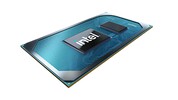Intel Core i5-1145G7 vs Intel Core 2 Duo T9300 vs Intel Core 2 Duo T6770
Intel Core i5-1145G7
► remove from comparison
The Intel Core i5-1145G7 is a power efficient quad-core SoC for laptops and Ultrabooks based on the Tiger Lake-U generation that was announced early 2021. It integrates four Willow Cove processor cores (8 threads thanks to HyperThreading). The base clock speed depends on the TDP settings and ranges from 1.1 GHz (12 Watt TDP) up to 2.6 GHz (28 Watt). The Boost is always specified at 4.4 GHz (one or two cores).
Another novelty is the integrated Xe graphics card with 80 EUs based on the completely new Gen 12 architecture. It offers a significantly higher performance compared to the older Iris Plus G7 (Ice Lake).
Furthermore, Tiger Lake SoCs add PCIe 4 support (4 lanes), AI hardware acceleration, and the partial integration of Thunderbolt 4 / USB 4 and Wifi 6 in the chip. In addition to this, the i5 supports vPro for easy remote management.
The chip is produced on the improved 10nm SuperFin process at Intel that should be comparable to the 7nm process at TSMC (e.g. Ryzen 4000 series).
All articles on Tiger Lake can be found on our Tiger Lake architecture hub.
Intel Core 2 Duo T9300
► remove from comparison
The Intel Core 2 Duo T9300 was a upper middle class dual core CPU for laptops, at the time of introduction. It is similar to the Core 2 Duo T9400 but features a slower clocked front side bus.
Due to the relatively high clock speed and 6MB Level 2 cache, the T9300 offers enough performance for most demanding games (in 2009) and applications.
The T9300 uses a Penryn (Montevina Update) core that features 2 integer units, 1 floating point unit, 1 load unit, and 1 store unit in a 14-stages long pipeline. Due to the Wide Dynamic Execution Technology, the core is able to simultaneously execute up to four instructions.
The integrated Enhanced Speedstep is able to downclock the core dynamically to save power (in idle mode).
Intel Core 2 Duo T6770
► remove from comparisonThe Intel Core 2 Duo T6670 is a laptop processor based on the Penryn core. It offers only 2 MB level 2 cache and is therefore slower than other 2.3 GHz clocked Core 2 Duo CPUs.
| Model | Intel Core i5-1145G7 | Intel Core 2 Duo T9300 | Intel Core 2 Duo T6770 | ||||||||||||||||||||||||||||||||
| Codename | Tiger Lake-UP3 | Penryn | Penryn | ||||||||||||||||||||||||||||||||
| Series | Intel Tiger Lake | Intel Core 2 Duo | Intel Core 2 Duo | ||||||||||||||||||||||||||||||||
| Series: Core 2 Duo Penryn |
| ||||||||||||||||||||||||||||||||||
| Clock | 2600 - 4400 MHz | 2500 MHz | 2300 MHz | ||||||||||||||||||||||||||||||||
| L1 Cache | 320 KB | 128 KB | |||||||||||||||||||||||||||||||||
| L2 Cache | 5 MB | 6 MB | 2 MB | ||||||||||||||||||||||||||||||||
| L3 Cache | 8 MB | ||||||||||||||||||||||||||||||||||
| Cores / Threads | 4 / 8 | 2 / 2 | 2 / 2 | ||||||||||||||||||||||||||||||||
| TDP | 28 Watt | 35 Watt | 35 Watt | ||||||||||||||||||||||||||||||||
| Technology | 10 nm | 45 nm | 45 nm | ||||||||||||||||||||||||||||||||
| max. Temp. | 100 °C | 105 °C | |||||||||||||||||||||||||||||||||
| Socket | BGA1449 | BGA479, PGA478 | |||||||||||||||||||||||||||||||||
| Features | DDR4-3200/LPDDR4x-4266 RAM, PCIe 4, 4 GT/s bus, DL Boost, GNA, vPro, MMX, SSE, SSE2, SSE3, SSSE3, SSE4.1, SSE4.2, AVX, AVX2, AVX-512, BMI2, ABM, FMA, ADX, VMX, SMX, SMEP, SMAP, EIST, TM1, TM2, HT, Turbo, SST, AES-NI, RDRAND, RDSEED, SHA, TME | Virtualization Technology (VT-x), Trusted Execution, Intel 64, Enhanced Speedstep, Execute Disable Bit | |||||||||||||||||||||||||||||||||
| iGPU | Intel Iris Xe Graphics G7 80EUs (400 - 1300 MHz) | ||||||||||||||||||||||||||||||||||
| Architecture | x86 | x86 | x86 | ||||||||||||||||||||||||||||||||
| Announced | |||||||||||||||||||||||||||||||||||
| Manufacturer | ark.intel.com | ark.intel.com | |||||||||||||||||||||||||||||||||
| FSB | 800 | 800 | |||||||||||||||||||||||||||||||||
| Transistors | 410 Million | ||||||||||||||||||||||||||||||||||
| Voltage | 1-1.25V V | ||||||||||||||||||||||||||||||||||
| Die Size | 107 mm2 | ||||||||||||||||||||||||||||||||||
| $316 U.S. |
Benchmarks
Average Benchmarks Intel Core i5-1145G7 → 0% n=0
Average Benchmarks Intel Core 2 Duo T9300 → 0% n=0
* Smaller numbers mean a higher performance
1 This benchmark is not used for the average calculation













